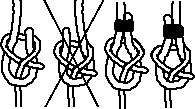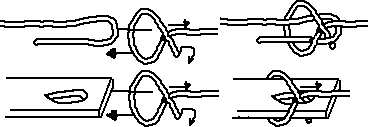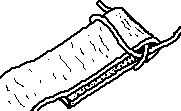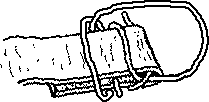![]()
Standard copyrights and disclaimer. The Sheetbend Family (
|
![]()
![]() The sheetbend is a bend. There is a page on bends
The sheetbend is a bend. There is a page on bends ![]() The Sheet Bend, general.
The Sheet Bend, general.

The sheet bend is my favorite bend. Be carefull. With the loose end on the wrong side
you have an other, weaker knot (Left-hand sheetbend). If the knot is well seized it does
not matter if it is tied right or left handed
The sheetbend on
the WEB.
This way of tieing is for connecting equally sized ropes to each other. When the ends
are connected you have the Bowline Knot. You have to
try to take the first 'steps' as one simple clockwise turn of your wrist. So practice...
The wever_sheetbend

If you want to tie two thin yarns to each other you use a wever-knot. The one shown
here is the same as the Sheet Bend. If the yarn is slippery use an Overhandknot on the ends before tying this knot. If
this ends up into a to bulky knot you need an other wever_knot.
Sheet Bend for a (to) short end.

With the simplest noose you can catch an end and capsize the knot to a sheed bend. Be
careful. without practicing you have a 50% change of catching it wrong. Also, (as always)
working up the knot properly is important.
 The Lap Knot sometimes
is called the false sheetbend. But false knots do not exist. The Lap knot has been in use
for ages by many civilisations. I use the name Lap knot because that is the name Robert
Pont used in his description of this knot. He found it was used in Lapland in a lot of
applications. Especially in lether, it is very suitable, just as secure as the sheetbend,
but even more easy to untie. That is important, especially when your fingers are cold.
The Lap Knot sometimes
is called the false sheetbend. But false knots do not exist. The Lap knot has been in use
for ages by many civilisations. I use the name Lap knot because that is the name Robert
Pont used in his description of this knot. He found it was used in Lapland in a lot of
applications. Especially in lether, it is very suitable, just as secure as the sheetbend,
but even more easy to untie. That is important, especially when your fingers are cold.
 The Lap Knot is the
knot to tie a rope to a strap. If the strap is hard to bend and the rope is slippery, it
is advisable to add an overhand knot at the end. Robert Pont thinks it is the best solution
for this special situation. He tested it with a many heavy loads under hard conditions.
Every time with the same strap, and the same rope. It did not slip a bit, in rain,sun, and
snow during several months.
The Lap Knot is the
knot to tie a rope to a strap. If the strap is hard to bend and the rope is slippery, it
is advisable to add an overhand knot at the end. Robert Pont thinks it is the best solution
for this special situation. He tested it with a many heavy loads under hard conditions.
Every time with the same strap, and the same rope. It did not slip a bit, in rain,sun, and
snow during several months.
 If the Lap Knot is
the knot for tieing a rope to a strap it is certainly the knot to make a rope loop at the
end of a strap. With a bit of practice, you can enjoy its usefulness.
If the Lap Knot is
the knot for tieing a rope to a strap it is certainly the knot to make a rope loop at the
end of a strap. With a bit of practice, you can enjoy its usefulness.
 Ever needed a
slipped knot which holds secure and releases instantly when pulled? tie the slipped
version of the Lap-knot. You will be surprised. I saw this knot for the first time
observing a man who hung sausages on a line. He knitted the line into a small noose and
shifted the slipped loop over it making a slipped Lap knot. When he needed a sausage he
simply grabbed an end and pulled. No scissors, no tools.
Ever needed a
slipped knot which holds secure and releases instantly when pulled? tie the slipped
version of the Lap-knot. You will be surprised. I saw this knot for the first time
observing a man who hung sausages on a line. He knitted the line into a small noose and
shifted the slipped loop over it making a slipped Lap knot. When he needed a sausage he
simply grabbed an end and pulled. No scissors, no tools.
![]()
![]() The sheetbend is a bend. There is a page on bends
The sheetbend is a bend. There is a page on bends![]()
![]()
Because this is an non-comercial site I can and will not allow junk mail nor spam. Therefore comercial, non personal and bulkmail will be charged with handling costs of $100 per mail.